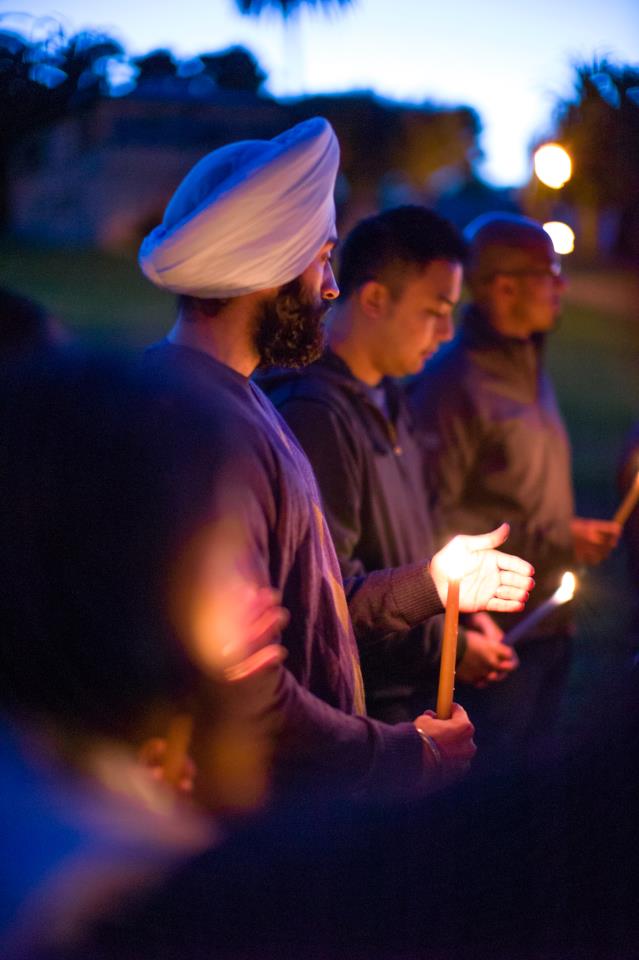“Fear none, frighten none,” is a core tenet of Sikh philosophy, one that Sikh Americans must draw upon when gracefully resisting injustices like unprovoked secondary screenings at airports, bullying in schools, and panicked checks in public places since 9/11. Similarly, Sikhs across the world have resisted other vile challenges to identity, freedom, and life many other times in history, in even more dire contexts.
Nevertheless, the continued ignorance of the history and belief system of the over half a million Sikh Americans remains deathly dangerous, as was demonstrated in Oak Creek, Wisconsin on Sunday morning. The attack and six murders, in the post-9/11 context, are traumatizing for those directly involved, and for all peoples targeted since 9/11.
It may seem like “just semantics,” but using the right language gives survivors control over the narrative of their experiences.
For any traumatized person or community, the choice of language immediately after the event is pivotal. Every day, in my work as a lawyer for victims of violence, I listen with care to women and children and men of many different races, cultures, and ethnicities. In our conversations, I employ the same terms they employ, whether they refer to someone as abuser or partner, or describe what has happened to them as an incident, beating, pounding, or abuse. Using the same words the person uses reflects active listening, respect for their choices, and an openness to diversity—the very basics of a trauma-informed response. It may seem like “just semantics,” but using the right language gives survivors control over the narrative of their experiences—and this was noticeably missing from the early hours of coverage of Sunday’s shooting.
While the valiant responses of the law enforcement—particularly Officer Brian Murphy, the 20-year veteran police officer who was ambushed with bullets and saved several lives—have provided reassuring hope, Sunday morning also highlighted general public unawareness that actually hurt post-emergency health and recovery for the community. The media’s ignorance about the world’s fifth-largest faith was apparent in the mispronunciation of the name of the faith (pronounced si:k/‘sick’ not ‘seek’), unawareness of the name of its place of worship (gurudwara, not temple), and failure to adequately acknowledge the grave extent of post-9/11 experiences of the community.
Sikhi (or Sikhism) is a monotheistic religion, which was revealed to Guru Nanak over 500 years ago in the Punjab, South Asia. It has over 25 million followers worldwide. There are half a million Sikhs in America. Sikhi preaches a message of devotion, while emphasizing truthful living, equality between all human beings, and social justice.
To serve as a constant reminder of their commitments, Sikhs are required to wear an external uniform, which includes uncut and unshorn hair. Obviously, like all faiths, not all members of the faith practice all the requirements fully, and some Sikhs may have shaved faces and short hair. But most of the men one sees in the United States who have a long beard and don turbans over uncut hair, are Sikhs. Similarly, Sikh women do not cut their hair and in fact some sport turbans as well. Turban-wearing Sikhs never appear in public without their turban and being asked to remove the turban in public is a matter of extreme disgrace.
Since 9/11, Sikhs, once part of the Asian model minority—educating their kids, working hard, contributing to society without demanding much in return—now often finding themselves having to defend their American-ness.
Countless Americans do not know about the significance of a Sikh’s turban. Unfortunately, since 9/11, images of bin Laden flashing on American TV screens have conflated the turban with something evil. In the surge of anti-Muslim, anti-Middle Eastern, anti-turban sentiment, Sikhs have been subjected to harassment, employment discrimination, and hate crimes. Since 9/11, several hundred bias incidents have been reported to the Sikh Coalition. Thus, Sikhs, once part of the Asian model minority—educating their kids, working hard, contributing to society without demanding much in return—now often finding themselves having to defend their American-ness.
The murders on Sunday highlight the urgency of dispelling half-truths that cause some communities to feel like second-class citizens in their own country. Just as education on safe relationships would help prevent domestic violence against some survivors, diversity education would help prevent ignorant hatred against all minorities—Sikhs, blacks, Muslims, and any other people who face vulnerability. Besides concerted programs, our everyday media reporting needs to continue taking on the responsibility to improve—the importance of which was demonstrated by the steep learning curve between Sunday morning and evening; for example, simply in learning that Sikhi is a distinct faith, one of the largest in the world, and that, having been present in the United States for over 100 years, American Sikhs are not an “obscure” community.
Certainly hate and terrorism against anyone cannot be condoned, but neither can ignorance. An ignorant and non-sensitive perspective in response to this kind of trauma is wrong not because it is “un-P.C.” but because it blatantly violates the spirit of religious pluralism. It disrespects the many victims, their families, and the valiant police officers who stood in their defense. Such a perspective creates an environment where more hate can simmer. It violently contradicts another central Sikh tenant, read out in gurudwaras multiple times every day: “sarbat the bhalla,” or the wellness of all peoples.

